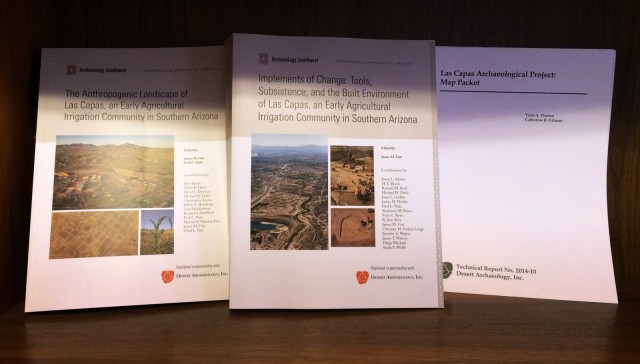- Home
- >
- Press Releases/Announcements
- >
- The Archaeology of Southern Arizona’s Early ...
Archaeology Southwest and Desert Archaeology, Inc., Publish New Works on the Archaeology of Southern Arizona’s Early Farmers
Tucson, Ariz. (August 1, 2015)—Tucson-based cultural resources management firm Desert Archaeology, Inc., has recently completed final reports on the Las Capas site, which provides substantial new insights into agricultural practices of the Early Agricultural period in the Tucson Basin. Archaeology Southwest, a private 501 (c) 3 nonprofit, has published the volumes through its Anthropological Papers series and its Technical Report imprint, in partnership with Desert Archaeology, Inc.

Las Capas: The Layers
Desert Archaeology conducted major excavations at the site of Las Capas, AZ AA:12:111 (ASM), between 2009 and 2013 under contract to Pima County. Las Capas is located in the northern Tucson Basin on the east bank of the Santa Cruz River, just downstream of the confluences of the Rillito and Cañada del Oro tributaries with the Santa Cruz in an ideal location for irrigation-based agriculture. Data recovery was conducted in advance of the expansion of Pima County’s Tres Rios Water Reclamation Facility. Las Capas dates primarily to the San Pedro phase of the Early Agricultural period, ca. 1200 to 800 B.C. Later, more sporadic occupation of the site extends from the Cienega phase (ca. 800 B.C.–A.D. 50) through the Hohokam and Protohistoric eras. Occupation prior to ca. 2100 B.C. is suggested by several radiocarbon dates on maize found redeposited in younger contexts.
Recent excavations at the site and associated its associated canals (designated as AZ AA:12:753 (ASM)) revealed the structure of this Early Agricultural period settlement in unprecedented detail. Data recovery identified more than 5,500 prehistoric features, of which 3,455 were excavated or tested. Investigated feature types included 53 pithouses (and 8 possible pithouses), 22 extramural surfaces, 610 bell-shaped pits, 49 large pits, 2099 small pits, 490 roasting pits, 40 pits of unknown or other function, 20 inhumations, 2 cremations, and 11 animal burials. These excavations resulted in the recovery of more than 113,000 artifacts and 7,300 samples of various kinds.
A well-organized and long-lived series of cultivated fields associated with the canals was identified—the best example of Early Agricultural period farming technology known to date. The large areas available for excavation allowed fields and canals to be exposed over broad areas; 15 hectares of fields could have been irrigated with ease based on the exposed portions of the system, modeled stream flow, and the physical characteristics of the canal and floodplain sediments. The detailed excavations also allowed for estimates of the labor expended in field construction. The practice of irrigated maize agriculture and the community organization needed to operate and maintain those systems was as significant to local communities as its overall contribution to diet.
The results of the Las Capas investigations are provided in a series of Anthropological Papers, Technical Reports, and a book published by Archaeology Southwest and Desert Archaeology. The two Anthropological Papers provide a broad overview and synthetic examination of the site, with a specific emphasis on the reconstruction of prehistoric life in the northern Tucson Basin during the Early Agricultural period San Pedro phase. The five Technical Reports include discussions of the field methods, feature descriptions and descriptions of the mortuary assemblage, and an experimental analysis examining Early Agricultural period agriculture and ground stone tool production. A map packet is also included as a Technical Report with areal maps showing the project area and feature location by individual locus.
The Anthropogenic Landscape of Las Capas, an Early Agricultural Irrigation Community in Southern Arizona (Anthropological Papers No. 50)
Edited by: James M. Vint, Fred L. Nials
Contributions by: Dirk Baron, Owen K. Davis, David L. Dettman, Michael W. Diehl, Christopher Eastoe, Jeffrey A. Homburg, Gary Huckleberry, Richard I. MacPhail, Fred L. Nials, Manuel R. Palacios-Fest, James M. Vint, Chad L. Yost
294 pages, 82 figures, 37 tables
Implements of Change: Tools, Subsistence, and the Built Environment of Las Capas, an Early Agricultural Irrigation Community in Southern Arizona (Anthropological Papers No. 51)
Edited by: James M. Vint
Contributions by: Jenny L. Adams, M. L. Brack, Rachael M. Byrd, Michael W. Diehl, Janet L. Griffits, James M. Heidke, Fred L. Nials, Stephanie M. Reyes, Stacy L. Ryan, R. Jane Sliva, James M. Vint, Christine H. Virden-Lange, Jennifer A. Waters, James T. Watson, Helga Wöcherl, Sarah E. Wolff
550 pages, 127 figures, 163 tables
Las Capas Archaeological Project: Map Packet (Technical Report 2014-10) (Hardcopy)
By Tyler S. Theriot and Catherine B. Gilman
70 pages and 60 figures
To order online, visit www.archaeologysouthwest.org/store/anthropological-papers/lcap-3.html, or call 520-882-6946.
About Desert Archaeology, Inc.
Desert Archaeology is an Arizona small business offering cultural resources research and consulting services through offices in Tucson and Phoenix. The company has been in the forefront of cultural resources management since 1982, serving a diverse set of clients—from government agencies to private firms. Desert Archaeology has successfully completed over 2,000 projects in the Greater Southwest, ranging from small surveys to large excavations. We have established a record of work that is timely, cost effective, and of the highest professional quality. Client service in an open, team-based environment is our hallmark. We have been very successful in serving the interests of our clients while preserving cultural resource values. Learn more at desert.com.
About Archaeology Southwest
Archaeology Southwest is a private 501(c)(3) nonprofit organization based in Tucson, Arizona, that explores and protects the places of our past across the American Southwest and Mexican Northwest. For three decades, Archaeology Southwest has practiced a holistic, conservation-based approach known as Preservation Archaeology. By exploring what makes a place special, sharing this knowledge in innovative ways, and enacting flexible site protection strategies, we foster meaningful connections to the past and respectfully safeguard its irreplaceable resources. Learn more at www.archaeologysouthwest.org.
Explore the News
-
Join Today
Keep up with the latest discoveries in southwestern archaeology. Join today, and receive Archaeology Southwest Magazine, among other member benefits.